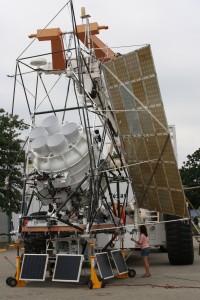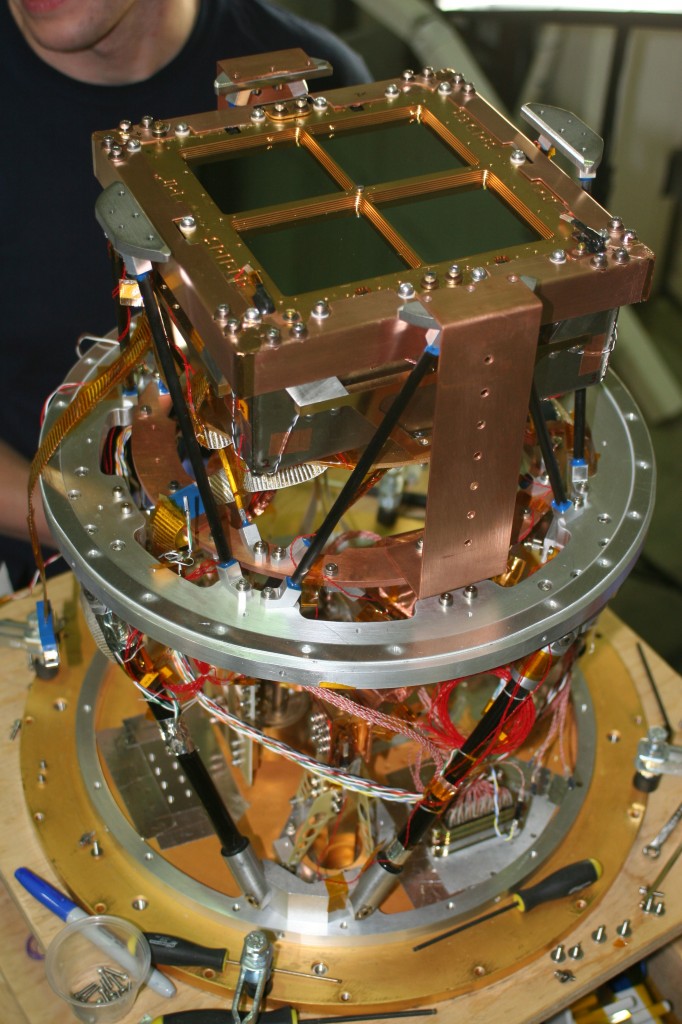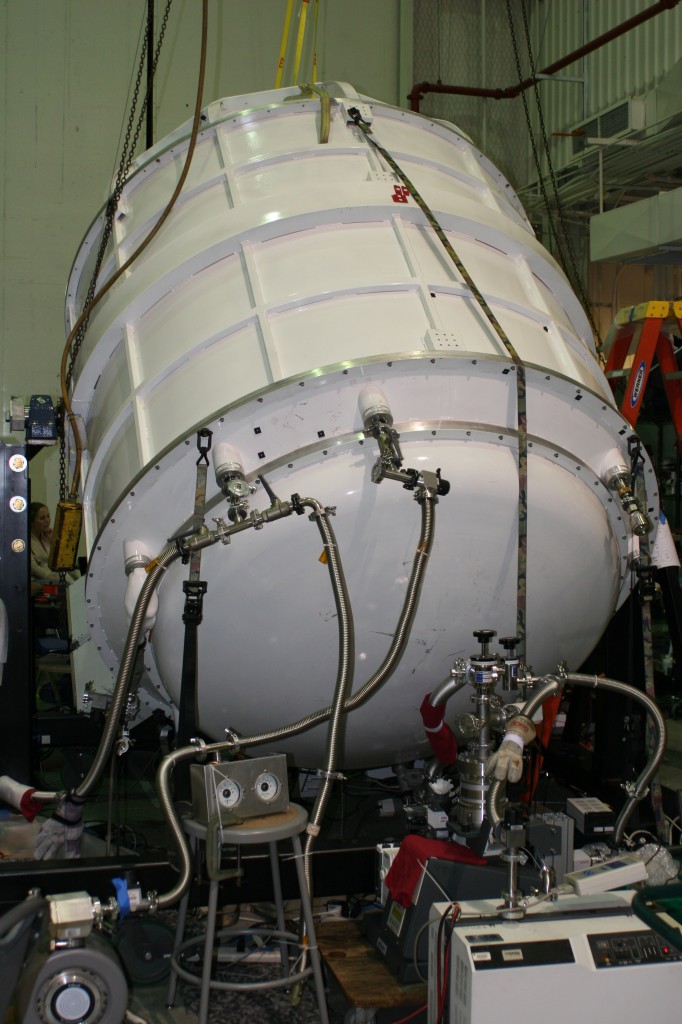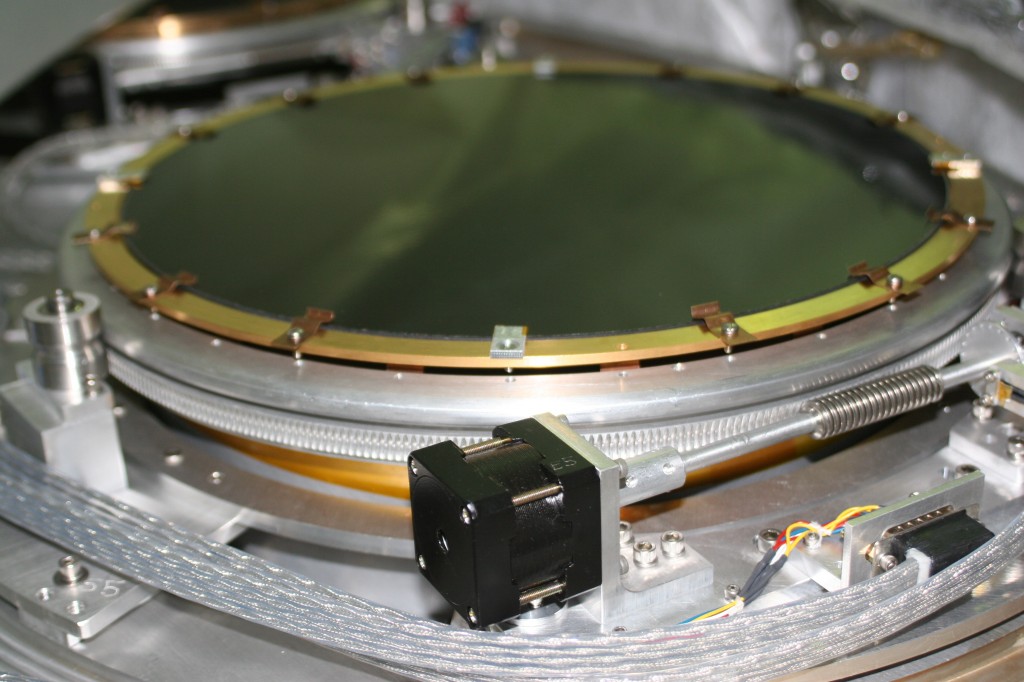 Spider is a balloon-borne instrument designed to search for the signature of primordial gravity waves that is (hopefully) encoded in the polarization of the CMB. The gravity waves are expected remnants from the epoch of Inflation – a period of exponential expansion of the universe when it was only (roughly, and if we’ve got this right) 10^-34 seconds old.
Spider is a balloon-borne instrument designed to search for the signature of primordial gravity waves that is (hopefully) encoded in the polarization of the CMB. The gravity waves are expected remnants from the epoch of Inflation – a period of exponential expansion of the universe when it was only (roughly, and if we’ve got this right) 10^-34 seconds old.
Spider’s design consists of six independent telescopes operating at two frequencies (90, 150GHz), with the optics cooled to 4 Kelvin and the bolometric detectors cooled to 0.25K.
We completed our integration with NASA’s ballooning flight systems in the summer of 2013 at CSBF in Palestine, TX. We were scheduled to fly a 20-day long-duration balloon (LDB) flight in December 2012 from Antarctica, but our program was delayed for a year due to the federal shutdown in October 2013. We hope to fly in December 2014.
The picture above shows Spider nearly fully assembled, though without its aluminized mylar walls and sun shields. As you can see in that picture, the gondola (built at U. Toronto) is made of lightweight carbon fiber tubes. It’s controlled by computers that tell it where to point (accomplished by motors that drive a reaction wheel on the azimuth axis, and which tilt an inner telescope frame relative to the outer frame forming an elevation axis), and which store the data from the cameras.
 This picture shows one of the Spider focal planes (built at Caltech/JPL), which consists of four “tiles”, each of which is an 8×8 array (for the 150GHz cameras) or 6×6 array (for the 90GHz cameras) of polarization sensitive pixels. The detectors are superconducting sensors that operate from a base temperature of 0.3 Kelvin, cooled by a custom Helium-3 refrigerator. (This particular focal plane happens to be one of the 90GHz ones, but the 150GHz ones look nearly identical).
This picture shows one of the Spider focal planes (built at Caltech/JPL), which consists of four “tiles”, each of which is an 8×8 array (for the 150GHz cameras) or 6×6 array (for the 90GHz cameras) of polarization sensitive pixels. The detectors are superconducting sensors that operate from a base temperature of 0.3 Kelvin, cooled by a custom Helium-3 refrigerator. (This particular focal plane happens to be one of the 90GHz ones, but the 150GHz ones look nearly identical).
The six telescopes and their cameras are cooled in this very large liquid Helium-cooled cryostat (built and debugged at Princeton), known to us as “Theo”. It holds nearly 1200 liters of liquid helium, hopefully enough to last through a 20 day flight before it all boils off and the system warms up. The telescopes look out the other end of Theo, as you can see in the first picture on this page. This photo shows the back size, where the cryogens are inserted.
This is the business end of Theo (where the photons come in), with the vacuum endcap and other shielding removed. Here you can see three 150GHz (dark) and two 90GHz (light) halfwave plates (built at Case); they’re different colors because we use different materials for the antireflection coatings on the sapphires. (One telescope is missing, hence the open tube on the lower left.)
This is one of the 150 GHz halfwave plates, mounted in its cryogenic rotator. The stepper motor and worm gear combination will be used to rotate the HWP by 22.5degrees once per day during flight. This rotates the polarization sensitivity of the detectors without significantly affecting their angular response on the sky.
There are many publications describing Spider in more detail:
- “SPIDER: Probing the Early Universe with a Suborbital Polarimeter”, A. Fraisse etal, http://arxiv.org/abs/1106.3087
- “Thermal architecture for the SPIDER flight cryostat”, J. Gudmundsson etal, http://arxiv.org/abs/1106.2507
- “Design and performance of the Spider instrument”, M. Runyan etal, http://arxiv.org/abs/1106.2173
- “SPIDER: a balloon-borne CMB polarimeter for large angular scales”, J. Fillipini etal, http://arxiv.org/abs/1106.2158
- “Spider Optimization II: Optical, Magnetic and Foreground Effects”, D. T. O’Dea etal, http://arxiv.org/abs/1102.0559
- “Modeling and characterization of the SPIDER half-wave plate”, http://arxiv.org/abs/1006.3874
- “SPIDER: A Balloon-borne Large-scale CMB Polarimeter”, B. P. Crill etal, http://arxiv.org/abs/0807.1548
- “Spider Optimization: Probing the Systematics of a Large Scale B-Mode Experiment”, C. J. MacTavish etal, arXiv:0710.0375
- “SPIDER: a new balloon-borne experiment to measure CMB polarization on large angular scales”, T. E. Montroy etal, Proceedings of the SPIE, ed L. M. Step, v 6267, p62670R, (2006). (This describes the Spider instrument as originally conceived.)
In addition to the effort at CWRU, the Spider collaboration includes groups at Caltech, JPL, U. Toronto, UBC, NIST, Cardiff, and the Imperial College of London.


